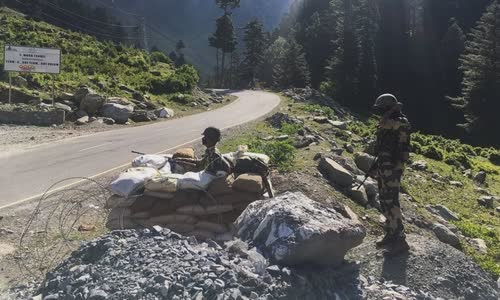Border disputes between China and India date back to at least 1914, and occasional serious fights and conflicts occurred.
The most violent clash in decades between Indian and Chinese army troops stationed on the disputed border on the Himalayas without any gunfire.

Soldiers from the Indian Border Security Force guard a highway leading to the town of Leh, near the border with China, on June 17. Photo: AFP.
Instead, soldiers from two nuclear-armed nations build weapons from what they can find in the barren land at 4,200 meters above sea level.
With sticks and bricks, under the moonlit sky along the jagged cliffs of the Galwan valley, they plunged into each other, brawling for hours.
The brawl occurred on the evening of June 15 when an Indian patrol team encountered a group of Chinese soldiers on a narrow ridge in Ladakh, Kashmir.
China accuses Indian troops of crossing the border and attacking soldiers, while India asserts that Chinese troops have crossed the Actual Control Line (LAC), which acts as a border between the two countries.
Soldiers from both sides did not open fire because of a 1996 bilateral agreement that "neither side could fire, use dangerous chemicals, carry out explosions or hunt with guns or explosives within two kilometers of
The clash was the result of escalating tensions accumulated over the months and over a century of disputes between the two countries.
The conflict lasted since at least 1914, when representatives of Britain, the Republic of China and Tibet gathered in Simla, what is now India, to negotiate a treaty to help settle the Tibetan issue and
The Chinese side did not agree with the terms proposed in the treaty, which allowed Tibet to enjoy autonomy but still under Chinese control, refusing to sign the agreement.
India considers the McMahon Road, which extends 885 km across the Himalayas, as the official legal border between India and China.
In 1947, India declared its independence from Britain.

Chinese soldiers guard the border line on Nathu La Pass in 1967 Photo: Hulton Archive.
Almost immediately, the two countries arose a disagreement on the border.
China is constantly seeking ways to control important roads near its western border in Xinjiang, while India and its Western allies consider intrusion from China as part of
In 1962, war broke out.
Chinese soldiers crossed the McMahon Road and took up positions deep within Indian territory, taking control of many passes and towns.
In November, Chinese Prime Minister Zhou Enlai announced a ceasefire, redrawing the border near the Chinese military occupation, taking the new name LAC.
Tensions again came back in 1967 along the Nathu La and Cho La passes connecting Sikkim, then a protectorate of India, to the autonomous region of Tibet, China.
A brawl arises when Indian soldiers place barbed wire along what they see as a border.
The clashes in September and October 1967 at Nathu La and Cho La passes were later considered to be the second comprehensive war between China and India.
India finally prevailed.
Twenty years later, in 1987, the Indian army conducted a training operation to assess how quickly they could send their troops to the border.

Chinese fighter jets parked at Gonggar airport in the West Tang autonomous region in June 1987 Photo: AFP.
Realizing the risk of accidentally triggering a war, both India and China were put down by the tensions, the crisis was repelled.
Both sides maintained the pursuit of a "cat and mouse" strategy.
After decades of border patrol, a Chinese platoon in April 2013 camped near Daulat Beg Oldi.
The camps were later fortified with troops and heavy equipment.
By May, the two sides agreed to dismantle both camps, but disagreements over the LAC's location persisted.
In June 2017, China embarked on a plan to build a road on the Doklam Plateau, an area controlled by the Himalayas in Bhutan, an ally of India.
The Doklam Plateau lies on the border between Bhutan and China but India sees it as a buffer zone adjacent to the disputed areas with China.
The Indian army carried weapons and bulldozers to confront China with the intention of destroying the road.
In August, the two countries agreed to withdraw from the disputed area and China stopped building the road.
Since May 2020, the fighting has broken out many times.
US President Donald Trump has proposed to mediate the dispute between India and China.



 Ziggy Elizabeth
Ziggy Elizabeth







